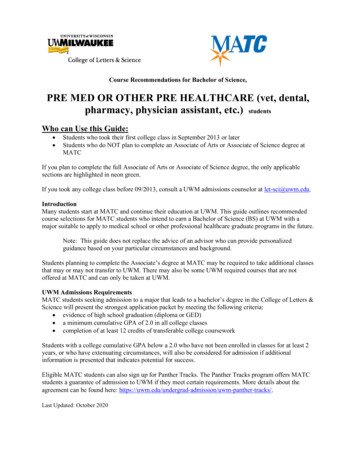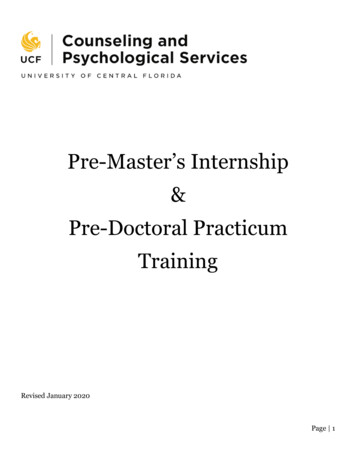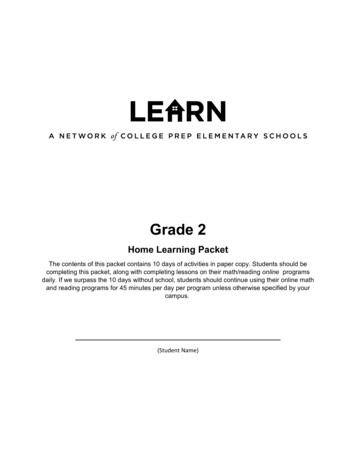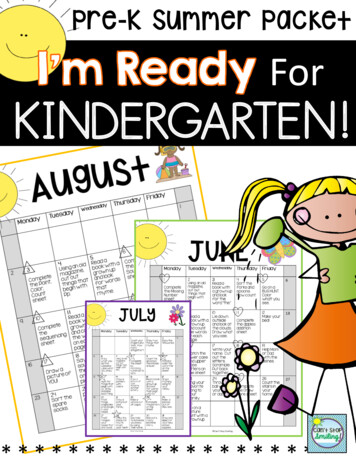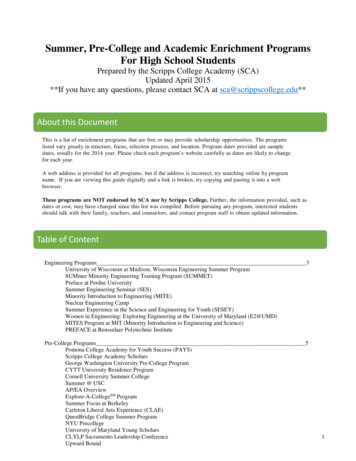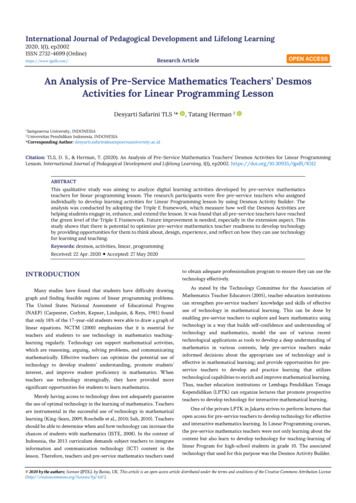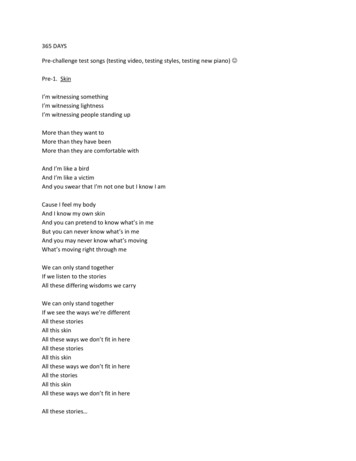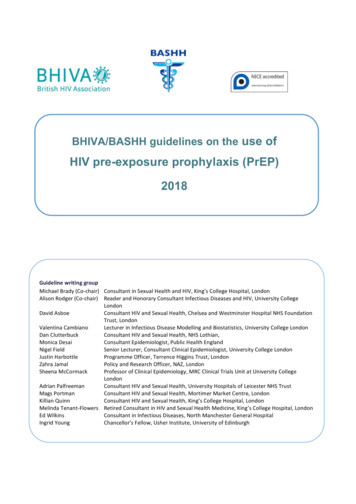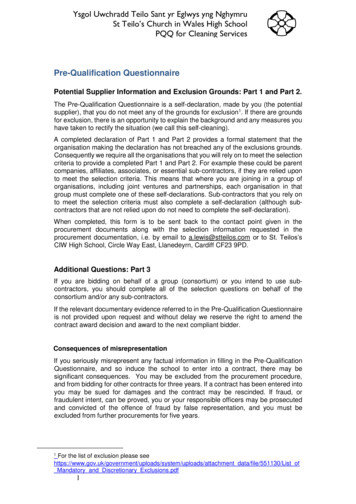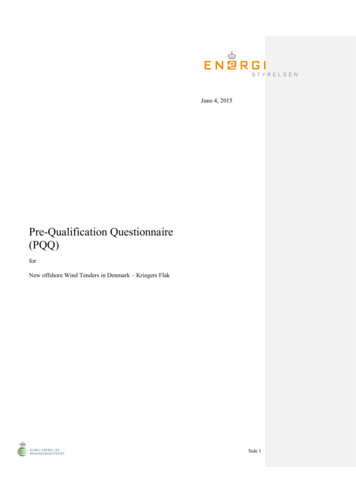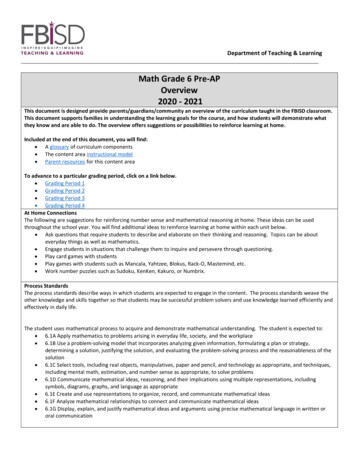
Transcription
Department of Teaching & LearningMath Grade 6 Pre-APOverview2020 - 2021This document is designed provide parents/guardians/community an overview of the curriculum taught in the FBISD classroom.This document supports families in understanding the learning goals for the course, and how students will demonstrate whatthey know and are able to do. The overview offers suggestions or possibilities to reinforce learning at home.Included at the end of this document, you will find: A glossary of curriculum components The content area instructional model Parent resources for this content areaTo advance to a particular grading period, click on a link below. Grading Period 1 Grading Period 2 Grading Period 3 Grading Period 4At Home ConnectionsThe following are suggestions for reinforcing number sense and mathematical reasoning at home. These ideas can be usedthroughout the school year. You will find additional ideas to reinforce learning at home within each unit below. Ask questions that require students to describe and elaborate on their thinking and reasoning. Topics can be abouteveryday things as well as mathematics. Engage students in situations that challenge them to inquire and persevere through questioning. Play card games with students Play games with students such as Mancala, Yahtzee, Blokus, Rack-O, Mastemind, etc. Work number puzzles such as Sudoku, KenKen, Kakuro, or Numbrix.Process StandardsThe process standards describe ways in which students are expected to engage in the content. The process standards weave theother knowledge and skills together so that students may be successful problem solvers and use knowledge learned efficiently andeffectively in daily life.The student uses mathematical process to acquire and demonstrate mathematical understanding. The student is expected to: 6.1A Apply mathematics to problems arising in everyday life, society, and the workplace 6.1B Use a problem-solving model that incorporates analyzing given information, formulating a plan or strategy,determining a solution, justifying the solution, and evaluating the problem-solving process and the reasonableness of thesolution 6.1C Select tools, including real objects, manipulatives, paper and pencil, and technology as appropriate, and techniques,including mental math, estimation, and number sense as appropriate, to solve problems 6.1D Communicate mathematical ideas, reasoning, and their implications using multiple representations, includingsymbols, diagrams, graphs, and language as appropriate 6.1E Create and use representations to organize, record, and communicate mathematical ideas 6.1F Analyze mathematical relationships to connect and communicate mathematical ideas 6.1G Display, explain, and justify mathematical ideas and arguments using precise mathematical language in written ororal communication
Department of Teaching & LearningGrading Period 1Unit 1: Adding and Subtracting Rational NumbersEstimated Date Range: Aug. 17 – Sept. 30Estimated Time Frame: 30 daysUnit Overview: In this unit, students will learn the meaning of integers, absolute value and rational numbers as well as how toclassify, compare and order rational numbers. Students will learn how to add and subtract integers and then rationalnumbers. Students will spend significant time modeling the operations in order to develop a conceptual understanding of theoperations and how/why they work the way they do when positive and negative numbers are involved. Instruction will includecontextual, real-world problems that allow students to reason through their work and justify the reasonableness of their solutions.At home connections: Ask student to share real world situations involving integers Discuss with student the difference between a fraction and an integer Use monetary examples to practice adding and subtracting integers (i.e. How much will you have left if you paid theperson that you owe 3 dollars and I give you 10 dollars for allowance? Write a mathematical sentence or equation for thissituation: -3 10 7) Use sport examples to practice adding and subtracting integers (i.e. A football team received a 5-yard penalty on the firstplay. On the second play, the team received a 10-yard penalty. How many yards was the team penalized on the first andsecond plays? Write a mathematical sentence or equation for this situation: -5 (-10) -15 or -5 – 10 -15Concepts within Unit #1Success Criteria for this conceptLink to TEKSLearning Math Online Explain a time you struggled and how you have overcome the struggle.TEKS: 6.1A, 6.1B, 6.1C, 6.1D, 6.1E, 6.1F, Explain strategies for learning math and your go to strategy.6.1GConcept #1: Integers and Absolute Value Graph a whole number and its opposite on a number line.TEKS: 6.2B, 6.2C, 6.2D Discuss and Identify the absolute value of an integer. Define numbers that are zero pairs. Explain how to compare integers on a number line by using symbols orwords. Write or say the order integers on a number line from least to greatest orgreatest to least Write or say the order of several integers that come from a real-worldsituation either greatest to least or least to greatestConcept #2: Understanding Rational Locate and graph a fraction and decimal and its opposite on a number line.Numbers Compare rational numbers on a number line by using inequality symbols orTEKS: 6.2A, 6.2B, 6.2C, 6.2D, 7.2Awords. Order a set of rational numbers on a number line from least to greatest orgreatest to least verbally and in writingConcept #3: Add and Subtract Integers Use models to represent integer operationsTEKS: 6.2B, 6.3C, 6.3D, 6.7A, 6.7C, 6.7D, Apply zero pairs when adding and subtracting integers.7.3A, 7.3B Connect models to algorithms for integer operations. Write an expression to represent a situation involving integers. Use properties of operations to solve problems involving addition andsubtraction of integers Solve problems with mathematical and real-world context involving additionand subtraction of integersConcept #4: Adding and Subtracting Solve problems involving addition and subtraction of positive fractions andRational Numbersdecimals
Department of Teaching & LearningTEKS: 6.2B, 6.2C, 6.3C, 6.3D, 6.7A, 6.7C,6.7D, 7.3A, 7.3BUnit 2: Multiplying and Dividing Rational NumbersEstimated Date Range: Oct. 1 – Oct. 9Estimated Time Frame: 24 daysUnit Overview: In this unit, students will discover algorithms for multiplying and dividing rational numbers (integers, fractions anddecimals) through exploration and modeling. Students will come to understand that multiplying any number by a positive fractionless than one will result in a smaller product than the original factor. Students will also learn that dividing any number by a positivefraction less than one will result in a quotient larger than the dividend. In the Pre-AP math class, students will extend theirunderstandings of integer operations to fractions and decimals and will work with both positive and negative fractions anddecimals. The concepts in this unit include the following: Multiplying and Dividing Integers, Multiplying Rational Numbers, andDividing Rational Numbers.At home connections: Use monetary examples to practice multiplying and dividing integers Ask student to find the recipe for his/her favorite food. Choose an ingredient in the recipe to highlight. Ask the student to usemultiplication to determine how much of the ingredient is needed if the recipe is doubled or halved. Have student to determine a fraction of a time (I.e. What is 1/3 of an hour? What is 0.25 of an hour?)Success Criteria for this conceptConcepts within Unit # 2Link to TEKSConcept #1: Multiplying and Dividing Use models to represent integer operations.Integers Connect models to the standard algorithm for integer operations.TEKS: 6.2B, 6.2C, 6.2E, 6.3C, 6.3D, 6.7A, Write an expression to represent a situation involving integers7.3A, 7.3BConcept #2: Multiplying Rational Numbers Explain why a number increases or decreases in value when it is multipliedTEKS: 6.3B, 6.3E, 6.4G, 6.7A, 6.7D, 7.3A,by a fraction.7.3B Estimate fractions and mixed numbers to a whole number or halves to find areasonable range of products. Use models to solve problems involving multiplication of positive fractionsand decimalsConcept #3: Dividing Rational Numbers Explain the connection between multiplying and dividing fractions.TEKS: 6.3A, 6.3E, 6.7A, 6.7D, 7.3A, 7.3B Estimate quotients of fractions and mixed numbers to a whole number orhalves to find a reasonable range of products. Use models to solve problems involving division of positive fractions anddecimals Make connections to the using models and the standard algorithm. Recognize that dividing by a fraction is the same as multiplying by itsreciprocal Solve division problems with fraction and/or decimals using the standardalgorithm
Department of Teaching & LearningGrading Period 2Unit 2: Multiplying and Dividing Rational Numbers (Continued)Estimated Date Range: Oct. 12 – Nov. 4Estimated Time Frame: 24 days (continued from Grading Period 1)See Grading Period 1 for detailsUnit 3: Proportional ReasoningEstimated Date Range: Nov. 5 – Nov. 27 and Nov. 30 – Dec. 18Estimated Time Frame: 27 daysUnit Overview: In this unit, students will develop proportional reasoning skills as they relate to fractions, decimals and percents.Students will represent percents with concrete models and pictorial models, such as 10x10 grids, strip diagrams and number linesthat will aid them in developing a proportional understanding of equivalent fractions, decimals, and percents. Students will alsouse their proportional understanding to find either the part, the whole, or the percent, given the other two values to aid insolving. The concepts in this unit include the following: Equivalent Forms of Fractions, Decimals, and Percents, Percent Applicationand Application of Ratios, Rates, and Proportions.At home connections: Ask student to create ratios using individuals in the household (I.e. 3 females to 2 males; 2 adults to 3 children) Use a bag of candy (Skittle, M&Ms, etc.) to provide students practice with creating part to part and part to whole ratios Have student to create a matching game for equivalent fractions, decimals, and percentages Ask student to find (at home or online) a representation of a gallon, a cup, a quart, and a pint of liquid. Play a game that requires the student to convert a customary measurement into other customary measurements (I.e. Agallon 4 quarts; A gallon 8 pints or A day 24 hours; A day 1,440 minutes) Ask student to estimate the tax of a sales item given a tax rate of 8%. Show student receipts of various sales item and ask them to calculate the tax rate. Have student to determine the cost of an item he/she would like to purchase after taking a percentage off, such as 25%.Concepts within Unit # 3Link to TEKSConcept #1: Application of Rate, Ratios,and ProportionsTEKS: 6.4A, 6.4B, 6.4C, 6.4D, 6.4E, 6.4H,7.3B, 7.4B, 7.4D, 7.4ESuccess Criteria for this concept Represent ratios using modelsRepresent a ratio using a fraction or decimalWrite ratios in multiple ways including as a fraction, verbally with the wordto, and with a colonUse objects to represent part to part and part to whole ratio comparisonsUse models to determine equivalent ratiosUse a ratio table to determine equivalent ratiosScale up and scale down to determine equivalent ratiosFind a multiplicative scale factor to determine equivalent ratiosRepresent a rate as a quotientExplain how a rate is a comparison of two quantities including providingexamples of ratesDetermine the rate in a given problemDetermine and apply unit ratesUse a rate to convert within a measurement system including metric andcustomaryConvert between measurement systems using a rate.Compare different ratios or rates to determine which ratio or rate isgreater, less, or better in context of the situation.
Department of Teaching & Learning Concept #2: Equivalent forms of Fractions,Decimals, and PercentsTEKS: 6.2E, 6.4E, 6.4F, 6.4G, 6.5C Concept #3: Percent ApplicationsTEKS: 6.5B, 7.3A, 7.3B, 7.4D, 7.13A, 7.13E,7.13F Use proportions to make predictions and comparisons involving ratios,rates of an unknown valuePredict and compare for a given part or whole, given an equivalent ratio orrate using a real-world word problemUse base 10 blocks to represent percents.Use a 100s grid to represent percents and their equivalent fraction anddecimal values.Use strip diagrams to represent benchmark fractions and percents.Represent percents with strip diagrams that shows a part to wholerelationship.Represent equal parts of the same whole with a percent, fraction, anddecimal.Use concrete models to generate equivalent forms of fractions, decimalsand percent.Generate equivalent forms of fractions, decimals and percents usingpictorial models.Generate equivalent forms of fractions, decimals and percents usingalgebraic methodsGenerate equivalent forms of fractions, decimals and percents in order tosolve problems.Use concrete and pictorial models to find the unknown value when thepart, percent or the whole is givenUse a model to find the unknown value when the part, whole or percent isgivenFind the whole given the part and percent.Find the part given the whole and the percent.Find the percent given the part and the wholeUse proportional reasoning and/or models to find the missing value (part,whole, or percent) when given the other values.Solve real-world problems involving:Percent increase/decreaseSales TaxGratuityIncome TaxDiscountSimple InterestCompound Interest
Department of Teaching & LearningGrading Period 3Unit 4: Multiple RepresentationsEstimated Date Range: Jan 6 – Feb. 3Estimated Time Frame: 20 daysUnit Overview: In this unit, students need to understand that there are multiple ways to represent a problem. Students willextend their knowledge of graphing ordered pairs (x, y) on the coordinate plane in quadrant 1, where x and y are positive wholenumbers, to graphing ordered pairs in all four quadrants where x and y are rational numbers. Students will identify theindependent and dependent variables from tables, graphs, and equations and explain their meanings in context of real-worldsituations. Students will explore the similarities and differences between additive ( y a x ) and multiplicative ( y ax )relationships and apply this knowledge to represent linear relationships using tables, graphs, equations, and verbal descriptions.At home connections: Have student to draw and label the axes and quadrants on the coordinate grid. Ask student to draw three, 2-dimensional shapes (I.e. square, rectangles, triangles, etc.)on the coordinate grid and labelthe ordered pairs of the vertices. Have student explain the difference between the equations y 2x and y x 2 and to provide a real-world example. Ask student to identify the “change” in the following situations: Max earns 12 per hour; The cost of the homecomingdance tickets is 7 per ticket.Concepts within Unit # 4Success Criteria for this conceptLink to TEKSConcept #1: Graphing on the Coordinate Plane Identify and label the four quadrants of the coordinate plane.TEKS: 6.6A, 6.6C, 6.11A Locate and determine which quadrant or axis an ordered pair is located. Graph ordered pairs of rational numbers. Name the ordered pair that represents a graphed point on the coordinateplane. Describe the relationship between points on a coordinate plane Describe the independent and dependent variable for a graph in context ofthe situation Explain the meaning of an ordered pair in real world situation. Graph a situation from a table or set of ordered pairsConcept #2: Additive vs. Multiplicative Identify an additive relationship from a table, graph, verbal description, orTEKS: 6.4A, 6.4B, 6.5A, 6.6A, 7.4Cequation. Identify a multiplicative relationship from a table, graph, verbal description,or equation. Identify similarities and differences between additive and multiplicativerelationships. Compare and contrast additive and multiplicative relationshipsConcept #3: Writing Equations and Translating Represent constant rates of change with verbal descriptions, tables, graphs,Between Viewsand/or equations.TEKS: 6.4B, 6.6B, 6.6C, 7.4C, 7.7A Understand how the parts of the equation y mx b are represented in eachof the representations. Calculate the constant of proportionality from tables, graphs, andequations. Identify the constant of proportionality in tables, graphs, and equations.Unit 5: Equations and InequalitiesEstimated Date Range: Feb. 4 – Mar. 5Estimated Time Frame: 20 days
Department of Teaching & LearningUnit Overview: In this unit, students will use the properties of operations and order of operations to generate equivalentexpressions. Students will write real world situations from both one-step and two-step equations, as well as write one-step andone-variable, two-step equations, and inequalities from verbal situations. Students will use concrete models, manipulatives, andinverse operations to solve one-and two-step equations and inequalities, represent solutions to equations and inequalities, anddetermine if a solution makes an equation or inequality true. In order to build conceptual understanding for solving equations it isessential that all the students have practice with writing equations, then representing and solving with models before solvingusing inverse operations. In the Multiple Representations unit, students wrote one-step and one-variable, two-step equationsfrom verbal descriptions, therefore embed real-life problems when solving equations.At home connections: Ask student to identify phrases or signs that represent inequalities in the real-world (I.e. a speed limit sign) Utilize websites such as Solve me Puzzles to practice finding the value of various shapes.Concepts within Unit # 5Success Criteria for this conceptLink to TEKSConcept #1: Generating Equivalent Factor composite numbers and re-write in exponential form.Expressions Expand exponent notation to generate and equivalent numeric value.TEKS: 6.7B, 6.7C, 6.7A, 6.7D Identify when two numeric expressions are equivalent. Find a single number solution for an expression with multiple steps usingthe order of operations. Find equivalent expressions for multi-step problems. Compare and contrast expressions and equations. Write expressions from models. Write expressions from verbal descriptions. Find the value of an algebraic expression when given the value of thevariables. Generate equivalent numerical expressions using order of operations. Use properties of arithmetic to generate equivalent numerical expressionsfrom mathematical situations and real-world scenarios. Use properties of algebra and arithmetic to generate algebraic expressionsfrom mathematical situations and real-world scenarios. Use models, pictures, and algebraic representations to determine if twoexpressions are equivalent.Concept #2: Writing Equations and I will identify situations as equations or inequalitiesInequalities Write an expression to represent a verbal situation for an equation orTEKS: 6.9A, 6.9C, 7.10A, 7.10Cinequality Write a one-variable two step equation that represents a situation Write a one-variable, two-step inequality that represents a situation Write an equation or inequality verbally (I.e. two times the value of x minus5 is greater than 3) Create a situation for a one-variable, two-step equation. Create a situation for a one-variable, two-step inequalityConcept #3: Solving Equations and Explain (written or verbally) what a solution to an equation representsInequalities Model a one-variable, one-step equationTEKS: 6.9B, 6.10A, 6.10B, 7.10B, 7.11A, 7.11B Model a one-variable, two-step equation Describe how to solve a one-variable, one-step equation Describe how to solve a one-variable, two-step equation using models. Make connections between using models and inverse operations Solve one-variable, one-step equations using inverse operations
Department of Teaching & Learning Solve one-variable, two-step equations using inverse operations.Solve equations from real-world situations.Explain (verbally or written) what the solution of an inequality representsGraph solutions for an inequality on a number lineModel one-variable, one-step inequalitiesModel a one-variable, two-step inequalityExplain/describe how to solve a one-variable, one-step inequality usingmodel or manipulativesExplain/describe how to solve a one-variable, two-step inequality usingmodels or manipulativesExplain and justify when to reverse the inequality symbol while solving aninequalitySolve a one-variable, one-step inequality using inverse operationsSolve a one-variable, two-step inequality using inverse operationsSolve a one-variable, one-step inequality from a real-world situationSolve a one-variable, two-step inequality from a real-world situation.Solve equations that represent geometric concepts including perimeter,area, measure of angle, supplementary angles and complementary angles.Unit 6: Geometric Application of EquationsEstimated Date Range: Mar. 8 – Mar. 12Estimated Time Frame: 20 days (continued in 4th grading period)Unit Overview: In this unit, students will explore relationships that exist in triangles: sum of angles in a triangle, when three sidelengths form a triangle, and the relationship between sides and angles in a triangle. It is important for students to have time toexplore these relationships before having a formal lesson during which they are explicitly given the relationships. Students willalso explore area formulas for parallelograms, triangles and trapezoids by decomposing the shapes and rearranging them. Bydoing so, they can relate them to other shapes and develop the formulas for finding area of these shapes. Finally, students willdeepen their understanding of volume by solving problems related to volume of rectangular and triangular prisms and pyramids.Throughout this unit, students should be writing and solving equations and inequalities.At home connections: Play an “I Spy” game that requires the student to identify parallelograms, triangles, rectangular and triangular prisms. Play a “Shape Guessing” game to help students describe the parts of a shape and utilize appropriate vocabulary (I.e. Hida shape behind your back and the student will ask questions about the shape, such as “Does the shape have four rightangles? Is the shape composed of two triangles?” Have student to find in the home objects representing parallelograms, triangles, rectangular prisms, and triangularprisms.Concepts within Unit # 6Success Criteria for this conceptLink to TEKSConcept #1: Properties of Triangles Understand that the sum of the angles in a triangle is 180 .TEKS: 6.8A, 6.10A Determine when 3 angles form a triangle. Find the missing angle in a triangle. Determine if three lengths could be the sides of a triangle. Understand the relationship between the side lengths and angles of atriangle. Determine when 3 side lengths form a triangle. Use the relationship between sides and angles of a triangle to identify/labelsides and angles of a triangle
Department of Teaching & LearningConcept #2: 2D MeasurementTEKS: 6.8B, 6.8C, 6.8D, 6.10A Concept #3: 3D MeasurementTEKS: 6.8C, 6.10A, 7.8A, 7.8B, 7.9A Decompose and rearrange parts of shapes to model area formulas of 2Dshapes.Relate the formulas for area of 2D shapes to the formulas for area of other2D shapes.Write an equation representing a problem situation involving area.Use equations to find the area of a 2D shape.Use equations to find a missing dimension of a 2D shape when given thearea.Interpret mathematical information related to area contained in a problemsituation in order to write an equation representing the situation.Write an equation to find missing dimensionWrite equations representing situations involving volume.Determine the volume of a rectangular prism.Determine the missing dimension of a rectangular prism when given thevolume.Identify whether a shape is a prism or a pyramid.Explain in words and mathematically the relationships between volume ofa pyramid and volume of a prism with congruent bases and heights.Determine which real-world applications are asking for volume.Identify the base of the prism or pyramid.Identify the height of the prism or pyramid.Identify the appropriate formula for the volume of the figureCalculate volume of triangular prisms and pyramids when given picturesCalculate the volume of rectangular prisms and pyramids when givenpicturesSolve application problems involving volume of rectangular and triangularprisms and pyramids.
Department of Teaching & LearningGrading Period 4Unit 6: Geometric Application of Equations (continued)Estimated Date Range: and Mar. 22 – April 12Estimated Time Frame: 20 days (continued from 3rd grading period)See Grading Period 3 for detailsUnit 7: Data and StatisticsEstimated Date Range: April 13 – May 7Estimated Time Frame: 18 daysUnit Overview: In this unit, students will determine which questions yield variable data and which questions do not. Studentswill represent and summarize categorical data using relative frequency and percent bar graphs, and will represent numerical datausing histograms, dot plots, stem and leaf plots, and box plots. Students will generate numerical summaries for data using mean,median, mode, range and interquartile range. Data distributions will be described based on their shape. For Pre-AP, students willmake comparisons of two sets of data represented in dot plots or box plots using center, spread, and shape.At home connections: Have student find the mean, median, and mode of the ages of the immediate or extended family. Have student create a dot plot or stem and leaf plot of the ages of the immediate or extended family.Concepts within Unit # 7Success Criteria for this conceptLink to TEKSConcept #1: Analyzing and Interpreting Categorical Data Create a frequency table to represent categorical data.TEKS: 6.12D, 6.13B Create a relative frequency table to represent categorical data Connect strip diagrams to percent bar graphs by creating asegmented (or stacked) bar graph. Create a percent bar graph to represent categorical data. (Barsare separate) Connect Determine the mode of the data Describe the variability, if any, in the dataConcept #2: Representing, Analyzing and InterpretingNumerical DataTEKS: 6.12A, 6.12B, 6.13A, 6.13B, 7.12A Create a dot plot, from numeric dataCreate a stem-and-leaf plot from numeric dataCreate a histogram from numeric dataCreate a box plot from numeric dataSolve problems from graphical representationsDetermine numerical summaries of data by calculating the mean,median, range and interquartile range (IQR) of the numeric data.Describe the shape of a data distribution using vocabulary such asskewed, left skewed, right skewed, symmetrical and uniformDescribe the center of the data using median and meanDescribe the spread of the data using the range and the IQRDescribe the variability of the dataSolve problems from graphical representationCompare the shapes of two sets of dataCompare the centers of two sets of dataCompare the spreads of two sets of dataUnit 8: Financial LiteracyEstimated Date Range: May 10 – May 26Estimated Time Frame: 13 days
Department of Teaching & LearningUnit Overview: In this unit, students will continue to learn about concepts affecting consumers. Students will learn thesimilarities and differences between debit cards and credit cards as well as the factors to consider when choosing abank. Students will experience balancing a checkbook register using their understanding of integer operations.At home connections: Discuss how to write a check for a specific amount and the importance of balancing a checkbook Discuss the differences between a credit card and a debit card and the advantages and disadvantages of using each card Require student to research various ways to pay for college (i.e. scholarships, loans, work-study, etc.) Ask student to share his/her interest, strengths, and skills and possible jobs that connect to those strengths andinterests. Have student research the starting income for the jobs aligned to his/her skills, interests, and strengthsConcepts within Unit # 8Success Criteria for this conceptLink to TEKSConcept #1: Credit Cards vs Debit Cards List features of credit cards.TEKS: 6.14B List features of debit cards. Compare and contrast credit cards and debit cards.Concept #2: Checking Accounts Explain features of a checking account.TEKS: 6.14A, 6.14C Understand checking account fees. Understand debit card fees. Identify withdrawals and deposits and record them on a checkregister Determine checking account fees and record them on a checkregister Balance a check registerConcept #3: Credit Reports Determine activities that lead to positive credit history andTEKS: 6.14D, 6.14E, 6.14Factivities that lead to negative credit history. Explain why a positive credit history is important Explain the length of time information is reported on a creditreport Explain how creditors use information on a credit report. Explain how consumers use information on a credit reportConcept #4: Paying for College Explain how scholarships pay for collegeTEKS: 6.14G Explain how grants pay for college Explain how work study pays for college Explain how student loans pay for college Explain how savings pays for collegeConcept #5: Jobs and IncomeTEKS: 6.14H Research jobs and record their education required and annualsalaryCreate a scatterplot to show the relationship between educationand incomeCalculate the effects of salaries on lifetime income
Department of Teaching & LearningGlossary of Curriculum ComponentsOverview– The content in this document provides an overview of the paci
Math Grade 6 Pre-AP Overview 2020 - 2021 This document is designed provide parents/guardians/community an overview of the curriculum taught in the FBISD classroom. This document supports families in understanding the learning goals for the course, and how stu
